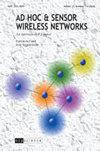3MRP+: An Improved Multimetric Geographical Routing Protocol for VANETs
IF 0.6
4区 计算机科学
Q4 COMPUTER SCIENCE, INFORMATION SYSTEMS
引用次数: 3
Abstract
The design of routing protocols in vehicular ad hoc networks (VANETs) is fundamental to achieve a high packets' delivery ratio. Routing protocols whose operation considers the nodes' positions use updated routing information according to the reception frequency of hello messages. The routing information can help to improve the routing operation by including several metrics such as vehicle's trajectory, vehicle's density, percentage of packet losses, among others. In addition, there is a trade-off between the beaconing frequency and the overhead injected to the network: a high frequency provides a better accuracy on selecting the best forwarding node to route a packet but at the same time the overhead is increased. However, a low frequency will provide less accuracy on selecting the best forwarding candidate node but the overhead injected to the network will be decreased. In this paper, we have designed an efficient method to improve the accuracy of the nodes' position used to select the next forwarding node without any modification on the beaconing frequency value. Our approach improves the operation of the routing protocol used in our performance evaluation. Simulations show the benefits of our proposal, increasing the accuracy of the nodes' selection and maintaining the same level of overhead, without the necessity to increase the beacon frequency.3MRP+:一种改进的vanet多度量地理路由协议
车辆自组织网络(VANETs)中路由协议的设计是实现高分组传输率的基础。考虑节点位置的路由协议根据hello报文的接收频率更新路由信息。路由信息可以帮助改进路由操作,包括几个指标,如车辆的轨迹、车辆的密度、包丢失的百分比等。此外,信标频率和注入网络的开销之间存在权衡:高频率在选择最佳转发节点路由数据包时提供了更好的准确性,但同时开销也增加了。然而,较低的频率会降低选择最佳转发候选节点的准确性,但会减少注入网络的开销。本文在不改变信标频率值的情况下,设计了一种有效的方法来提高节点位置选择下一个转发节点的精度。我们的方法改进了性能评估中使用的路由协议的操作。仿真结果显示了我们的建议的好处,提高了节点选择的准确性并保持了相同的开销水平,而无需增加信标频率。
本文章由计算机程序翻译,如有差异,请以英文原文为准。
求助全文
约1分钟内获得全文
求助全文
来源期刊

Ad Hoc & Sensor Wireless Networks
工程技术-电信学
CiteScore
2.00
自引率
44.40%
发文量
0
审稿时长
8 months
期刊介绍:
Ad Hoc & Sensor Wireless Networks seeks to provide an opportunity for researchers from computer science, engineering and mathematical backgrounds to disseminate and exchange knowledge in the rapidly emerging field of ad hoc and sensor wireless networks. It will comprehensively cover physical, data-link, network and transport layers, as well as application, security, simulation and power management issues in sensor, local area, satellite, vehicular, personal, and mobile ad hoc networks.
 求助内容:
求助内容: 应助结果提醒方式:
应助结果提醒方式:


